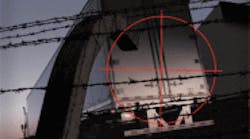“As an underwriter, if an account has top-notch risk control procedures in place, I definitely consider awarding credit to reduce the premium and deductible.” –Frank Buccafusco, regional underwriting director, Allianz Global Corporate & Specialty
Cargo theft is a big ongoing problem in the transportation business – and not just for truckers, mind you. According to the Federal Bureau of Investigation (FBI), cargo theft is estimated to cost the U.S. $15 billion to $30 billion a year, though the true measure may be even higher, since some businesses are reluctant to report thefts out of concern for their reputations or insurance premiums.
According to data compiled by FreightWatch International, truckloads containing $487 million of goods were stolen in the U.S. in 2009, a 67% increase over the $290 million worth of products swiped a year earlier. Altogether, thieves stole 859 truckloads in 2009, up from 767 loads in 2008 and 672 in 2007, the group noted – averaging out to 72 cargo thefts per month last year
“We’re finding cargo thieves are getting better at what they do,” Dan Burges, director of intelligence for FreightWatch, told me during an interview back in February. “We’re also seeing what we call the ‘rock in the river’ scenario playing out as cargo thieves are avoiding those carriers and shippers that are beefing up security measures in search of easier targets – much the way water flows around a rock to find the path of least resistance.”
He added that cargo thieves are also becoming more aggressive and are willing to take more chances than in the past. Part of that is due to the higher average value of truckload shipments: in 2008, the average value hovered around $378,000 per load; last year, it reached $566,000 per load.
[Last year, Joe Wehrle, president of the National Insurance Crime Bureau (NICB) gave a speech laying out the threat cargo theft poses not just to transportation but to the U.S. economy -- if not the global economy -- as a whole. You can view some of his remarks below.]
The loss of a customer’s cargo and the motor carrier’s equipment carrying it obviously creates heartburn for any trucker. But cargo theft’s impact on insurance premiums is what really concerns truckers – to the point that many simply DON’T report thefts for fear their insurance premiums will spike, or their coverage will be revoked altogether.
With that concern in mind, I decided to get together with some trucking insurance experts to find out what the real deal is regarding the fallout from cargo thefts.
I sent questions to two experts with Allianz Global Corporate & Specialty (AGCS), a leading property and casualty insurance company providing insurance and risk management services to marine (under which trucking is grouped), aviation, energy and other businesses.
The first is Craig Kolakowski (seen below), a risk consulting manager with 22 years of experience in the insurance loss control industry. A member of the Inland Marine Underwriters Association (IMUA) loss control and claims technical committee, Craig co-authored an IMUA technical paper on motor truck cargo conveyance and security.
The second is Frank Buccafusco, regional underwriting director with AGCS, who’s worked in the insurance industry since 1962. He has over 20 years experience underwriting over-the-road transportation business.
Q: How important is a fleet owner’s risk management program in reducing cargo theft?
Craig Kolakowski (CK): It’s essential these companies have a risk management "culture" where every single employee feels it’s important to protect the company's operations from theft. This is usually demonstrated by a well-publicized and distributed “standards of care” policy, along with a comprehensive audit program.
Frank Buccafusco (FB): As an underwriter, if an account has top-notch risk control procedures in place, I definitely consider awarding credit to reduce the premium and deductible. In the final analysis, though, I need to ensure that the premium is sufficient to cover the exposure at hand.
Q: Give an example of a common “red flag” that might cause a motor truck carrier account to be unattractive to an insurer?
FB (at right): The first thing an underwriter should look at is prior loss history. If the account is showing theft losses with more frequency than severity, it indicates the owner isn’t taking the necessary steps to prevent such losses. A frequency of a specific type of loss, especially if it’s associated with a highly theft-attractive product, also creates a concern. In addition, we pay close attention to theft activity that takes place in similar locations within the company’s operational locations.
CK: As a risk consulting manager, if the carrier has a poor loss history, I expect them to be able to articulate the procedures they have implemented to address and correct the problem. Transparency is crucial as I need to understand the exact preventative actions being implemented so I can provide a recommendation to the underwriter about the potential effectiveness of the measures. In addition, this transparency supports my ability to provide added-value to the client by analyzing their procedures and helping them incorporate proven measures that effectively reduce risk. This partnership is invaluable to the loss control and underwriting departments, as well as the client.
FB: When I receive a loss control report on an account that reveals a poor loss history, but the client is taking steps to correct the situation, I might say to the client, “We can see that you’re moving in the right direction, but we don’t know if your new procedures will work.” In these cases, we might put a higher deductible on the policy for the first year. In addition, we might add in a “no claims bonus” to show good faith on our part. If the client doesn’t have any claims in that initial year, we would consider allowing a return of 5% to 10% of the premium.
Q: What type of cargo theft security measures and devices are considered to be enhancements by insurers?
CK: For high-value and highly-targeted commodities, I look for clients who use devices that monitor driver activities. When necessary, these devices should be capable of alerting appropriate responders – whether law enforcement and/or accountable company management – that a driver who is transporting goods is deviating from standard policy.
FB: The required security measures all depend on the commodities that are being transported. Obviously, there are a number of systems that we expect clients to have in place, e.g. GPS devices and affiliations with information-sharing systems like CargoNet. In certain circumstances, though, the commodities might not require GPS or an alarm system. Whatever the case, we would never want a truck to be left unattended, so we look for a two-driver arrangement.
CK: We expect the client to have a layered approach to cargo security. They need to evaluate what the threats are throughout the transporting process and then demonstrate they’re utilizing the appropriate protocol and security devices. For example, an LTL carrier might be making stops for multiple customers. In this case, we would want them to clarify the various safety precautions being taken for the highest level of theft-attractive cargo being transported though that lane. It’s vital that loss control has all this information so we can accurately inform our underwriters if the client is properly evaluating and addressing all risks. Once again, it comes down to transparency, which benefits both the insurer and the client.



